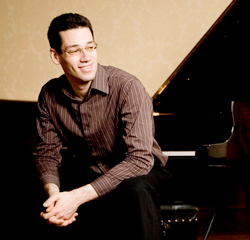by Daniel Hathaway

After discussing the century-old, three-course-meal approach to piano recitals, Biss wrote, “I think I speak for many contemporary pianists in saying the only remaining rule in planning a program is that all the pieces on it should have something to say about one another…that ‘something’ needn’t be admiring. It could be confrontational, or the act of one-upmanship, or reflect the anxiety of influence.”
For his performance on January 20, Biss crafted a palindromic program that began and ended with Beethoven sonatas (an early one and a late one), featured Robert Schumann’s Waldszenen at its center, and travelled there and back again via pieces by Arnold Schoenberg and Alban Berg. Each composer was engaged with “his own private battle with tradition,” Biss wrote. Both inspired and stifled by the past, each worked out his own approach to dealing with what had gone before.
Beethoven’s first official piano sonata, op. 2, no. 1 in f, found the composer solidly indebted to Haydn but stretching his wings in idiomatic ways. Near the other end of his 32 sonatas, in No. 28 in A, op. 101, Beethoven is supremely confident in creating his own musical architecture, difficult as it may be to describe in words — or to interpret in performance.
In the earlier sonata, Jonathan Biss caught the restless urgency of its opening movement, settled down for a calm and ruminative Adagio, brought out the capriciousness of its minuet, and took the sonata to a thrilling, almost breathless Prestissimo conclusion. In the later work, he resisted the temptation to gloss over Beethoven’s innovative oddities, drilling into the Schumannesque dotted rhythms of the Vivace alla marcia, and taking the audience on a fast, wild ride in the final Allegro.
Schoenberg’s Sechs Kleine Klavierstücke, op. 19 are pithy, rigorously constructed miniatures that both explained and provided a foil to Alban Berg’s luscious Sonata, op. 1. Playing with sensitivity and commitment, Biss treated them as equals, finding each alluring on its own terms.
Robert Schumann’s Forest Scenes, op. 82, paint nine short vignettes steeped in the magic — and the danger — that the woods represented to German romantics. Biss presented them charmingly — or menacingly, in the case of Verrufene Stelle (“Haunted Place”) and Vogel als Prophet (“Bird as Prophet”), underlining their cheerfulness or harmonic strangeness as the subject demanded.
Leading the good-sized audience so logically and gently from Beethoven to Schoenberg to Schumann, onward to Berg and back to Beethoven again, Jonathan Biss clearly won their confidence and admiration. They gave him a warm ovation at the end, and as a parting gift, he responded with the slow movement of Mozart’s second sonata, in another thoughtful and insightful reading.
Published on ClevelandClassical.com January 26, 2015.
Click here for a printable copy of this article



